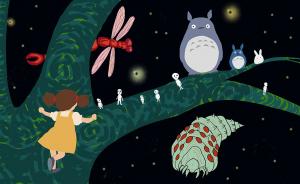
Curious Sucharita discovers how the overuse of antibiotics in fish farming can build superbug resistance — and what judicious use can do to stop it.

Guess who’s who in the wild—meet some furriest, funniest, and most fascinating mammals through clever riddles!

Most people would agree that playing God is unethical but bioengineering DNA could also be used to resurrect extinct species and improve science

Join Shyam and Uncle Green Hands on a journey of mending, reusing, and greening the world with seed balls and care!

Entering the weird, whimsical, and enchanting world of nature in Studio Ghibli movies

When a man drifts into a jungle and earns the trust of its creatures, what follows? 'Ek Tha Jungle' unveils the cruelty of human ambition and the bleak future we so razenly march toward.

“Jhuru . . . jaldi neeche aao,” Amma shouts.
Jhuru is atop a hill with his friend Bagha the leopard sprawled next to him.
“Bagha, why do they always call me when I am with you?”
“Well, they don’t want us to be together,” says Bagha licking his paws.
“Or are they scared?” Jhuru asks. He gets up and shouts, “Amma, aataa” and proceeded to sprawl again next to Bagha.
.png)
Where happiness comes in small packages—the ever-delightful house sparrow.
************************************************************************************
We often ignore our immediate periphery in our quest for finding excitement. Just think of the house sparrows! As a kid, out of sheer ignorance, I recall embarrassingly how I plundered their nests. But now, I compensate by feeding their chicks, watering them, and sheltering them in their cushy abodes.
In all this while, these humble birds never ever deserted their homes nor me...

Thanks to the real-life bat, the reel-life Batman became a superhero. I have vivid childhood memories of the trees near my school from which more bats hung than leaves. During summery dusks, they’d glide away en masse in a procession. I believe, even then as today, people would’ve been susceptible to the viruses spread by their droppings. But such cases were unheard of. Rather, people fed upon this fascinating creature to cure their ailments— like, rheumatism, asthma, and chest pain; and used bat hair to treat shivering during fever.

Whenever that sweet tinkling sound traverses through my balcony, my entire mood rejuvenates. I crane my neck, investigating its source, and scan my lushy green enclave for a soft jingling song. Tracing the tsee…tseer… notes, I rejoice with delight on spotting the chirpy, cute, bundle of joy—the Indian White-Eye.

“Why didn’t you spot the Tiha today, dear?” That’s what my mother used to remind me on the New Year eves, when I was a little child like you. The Indian Roller bird, or the Tiha in Odia, is a very good omen. Believed to be a harbinger of happiness, sighting it is considered auspicious, especially at the beginning of any major life event. In fact, such is the faith in its sanctity that its feathers are preserved as lucky charms. Do you know Odisha, Telangana, and Karnataka have also declared it as their state bird?

If there is ever a bird that can rival even a hulk in roaring aloud, then that birdy has to be the Brown-Headed Barbet. This little creature’s blaring decibels can screech through the morning silence and can knock anyone out of their afternoon siesta as well. Its challenging, almost enticing, avian call proceeds like: tur-r-r-r kutrook-kutrook-kutrook...

If there was ever a parliament of birds, then this avian would have delivered the most vociferous speeches. No doubt quirky artists caricatured it in their popular Angry Birds game. I’m sure you all must have enjoyed playing this viral pastime and gotten amused by the perpetual furious look on the birds' faces. Recognised as the most argumentative bird, the Jungle Babbler couldn’t be named more aptly...

This bird, the Oriental Magpie-Robin, is a master of vocabulary. It can mimic other birds and animals flawlessly. It is also as expressive and emotive as the late actor Irrfan Khan. It is vocal on emotions but expresses only when the need is unavoidable.

From pollinators to silk weavers, moths play a crucial role in our ecosystem. Discover their beauty, importance, and an incredible rearing journey!

A high schooler’s journey to uncover the mystery behind disappearing butterflies and some simple ways we can all conserve them.

An invitation to listen to the many ecological secrets, stories, and knowledges shared in our diverse mother tongues

Stories travel fast. Love stories travel faster. In the last couple of decades, Valentine’s Day, celebrated on February 14, has become a global festival. What is the green angle to it?

